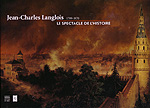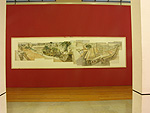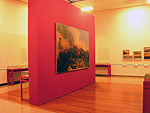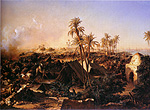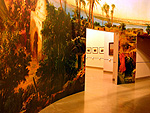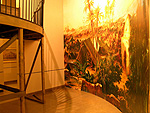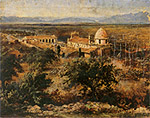The browser will either open the file, download it, or display a dialog.
|
Jean Charles Langlois 1789-1870. Le Spectacle de l'histoire |
||||||
|
Fragments of a Dream (History)1 | |||||
| This monographic exhibition devoted to Jean Charles Langlois, a relatively unknown nineteenth-century French painter and panoramist, is not a typical ramble through the career development of an artist whose place in the history of art is secure (fig.1). Rather, it is an exceptional exploration of an artist who saw himself as both a painter and an author of history. Prefiguring a master such as filmmaker Sergei Eisenstein, Langlois' goal was no less than to visualize contemporary history. Colonel Langlois, as he was most commonly known, represented, in the grandest form available to him, the epic events of his lifetime—from the battles of Napoleon in Egypt and Moscow, to those of his nephew, Napoleon III, in Crimea and at Solferino. Langlois's achievement was to take a dying form of popular entertainment and turn it into a new means for projecting French military history. The descendents of this cultural form continue to flourish today, in cinemas, IMAX theaters, and videogames. | ||||||
| As Walter Benjamin wrote, panorama rotundas were the dream houses of French society in the nineteenth century, and his fragmentary historical study, The Arcades Project (Das Passagen-Werk), can serve as a model with which to examine this recent exhibition.2 For this show was also multifaceted, constructed of shards of history that provide meaning in a surprising and sometimes revelatory way. If we seek to comprehend the history of nineteenth-century France more fully, we ought to look more carefully at the images it projected. While numerous art historians have debated the political significance of avant-garde painting, far fewer have taken on popular culture as forms in themselves. The literary historian, Maurice Samuels, has recently written on the topic of French panoramas and their place in the history of mid-nineteenth-century France. "Offering up images of the nation's history in a public form in as visually realistic manner as possible, historical spectacles such as the panorama provided perspectives through which new individual and national identities could take shape through the consumption of a version of the past. To trace this process is to witness the formation of one of modernity's founding illusions."3 | ||||||
| To investigate the career of Jean-Charles Langlois naturally leads to an analysis of the illusions he produced; what was particularly illuminating about this exhibition was that the viewer was able to perceive the traces of the production of these illusions. Langlois's version of history is recreated through significant, mostly visual, elements. The production of history, whether through textual or visual means, requires a selective scrutiny of materials that always yields partial results. What is remarkable about panoramas is that they provided a complete illusion of reality, considered in their day to be truer than texts derived from citations and direct observation.4 Looking at Langlois's panoramas now is impossible. These grand objects have not survived history and the glorious wholes they once presented for public enlightenment and entertainment are now in ruins. Though many of the panorama canvases were reused to produce new panoramas, a few of them made wide-ranging tours and ended up who knows where. Unlike works of art, these objects were made as entertainment, and therefore lost their value as soon as the audience was no longer interested. All that is left are fragments, shreds of evidence, and traces of once-glorious edifices; this exhibition is composed of studies, maquettes, and photographs. Trying to piece Langlois's career together is like trying to relive a dream through a handful of remembered images. There are glimpses of brilliance that make one wonder, and delight, in their power to convey poignancy, but this history of the nineteenth century comes together like fragments of a dream. | ||||||
| Which makes it a truly honest, and exceptional, exhibition, without a doubt more meaningful than most. What are the fragments and what do they tell us? An introductory section, leading down a wide hallway, introduces Langlois as a historical figure with great ambitions, good credentials (actual letters from Girodet and Horace Vernet), and sustained regional connections. After training at the École polytechnique, Langlois became an officer/artist in the Grand Armée, eventually taking to the battlefield with Napoléon. During the Restoration, he again studied art, producing military portraits and history paintings for the Salon, and then engaged in a brief career as an illustrator for a military and picturesque history of Spain. In other words, he lived a widely varied life as a war hero (injured at Waterloo, aide-de-camp for général Petit) and an artist (Salon painter, illustrator) before finally turning his hand to what would become his lifelong passion, the creation of military panoramas. | ||||||
| The first of these was launched in 1827 and featured the naval battle of Navarino, a French victory over Turkish forces during the Greek War of Independence that occurred only a few years before. It was Langlois's brilliance to reinvent the panorama that, since Daguerre's invention of the diorama in 1822, had fallen into decline. His central innovation was to feature an event in the panorama, rather than merely to represent a place, as earlier panoramas had done ("to see history in the making" as François Robichon puts it, p.60). He added further interest, and a sense of reality, by reconstructing a portion of the one of the ships that took part in the battle, the Scipion, and installing it as the platform in the center of the panorama rotunda. The panorama rotunda was designed to accentuate the action of the scene, and to make the viewer feel a part of this historical battle. Though the rotunda is lost, it is not difficult to appreciate the audacity of representing contemporary history in this spectacular form, offering the illusion of living through an historical event. The outlandish premise worked and Langlois's panorama was a tremendous success, launching a career that the exhibition traces through the paintings, studies and photographs that Langlois made to prepare his panoramas. In addition, there were the actual descriptive booklets that viewers received, as well as a series of photographs featuring several of the panoramas themselves. | ||||||
| Thus prepared by the introduction, the visitor turns to see what is unquestionably the most impressive single work in the exhibition (fig. 2), a set of twenty-three large-scale pencil drawings, made with a camera obscura, and overlaid with watercolor, that combine to produce a panoramic image of The Siege of Algiers, the subject of Langlois's second panorama (1833). These images have been brought together for the first time from two separate collections, and more than anything else in the exhibition, provide a sense of the scale of a panoramic image, even though they are placed on a large flat wall. These are beautiful drawings individually, but when they are all seen together they provide a surprising sense of what the panorama must have been like for viewers of individual works of art. The whole is indeed greater than the sum of its parts, and the sense of an entire visual experience, as opposed to a discreet aesthetic one, is palpable. | ||||||
| Caroline Joubert, the curator at the Musée des Beaux-Arts responsible for the exhibition, placed a group of very impressive, small painted studies of Algiers from the museum's collection around the perimeter of this room. In these studies, a visitor could see that Langlois was interested in more than the geographical location as the focus of a panoramic view. Indeed, Langlois accompanied the expeditionary force that conquered the city—the purported subject of this panorama—and then returned in 1832 to make further studies. In the process, he produced over sixty small paintings on paper (now mounted on canvas) featuring various views of Algiers and its surroundings as well as drawings in pencil and charcoal. A judicious selection of seventeen paintings and seven drawings is hung in the room with the panorama studies, and brings to light Langlois's deep interest in the places he represented. The exhibition demonstrates how this practice persisted in Langlois career, even after he began making photographic studies instead of drawings. Never content to merely find the view and record the essentials, Langlois studied his locales in far greater depth than a panorama—which can only provide a single point of view—could represent. | ||||||
| Next Langlois moved to Moscow as an aide-de-camp for maréchal Maison. Combining his dual professions as officer and artist more than ever, he made panorama studies in the surrounding countryside that allowed him to provide secret information to the French government! His years in Russia (1834-39) may or may not have yielded any useful espionage, but he apparently got on royally with the Czar, and he managed to produce two panoramas in Paris featuring Napoleon's disastrous adventure there; the Panorama of the Battle of Moscow (1835), and the Panorama of the Fire of Moscow (1839). The former is represented in the exhibition by a seven-meter canvas depicting the military invasion, and the latter through four long canvases as well as some studies of Moscow achieved in the same manner as the studies for the Panorama of Siege of Algiers. One interesting comparative work in this section of the exhibition is Langlois's history painting, The Fire of Smolensk, submitted to the Salon of 1838. It is a dramatic and powerful image and serves to remind the viewer that Langlois did not just engage in popular entertainment, but also positioned himself as an artist in his own right. This demonstrates not only that these activities overlap, but that the panoramas emerged sometimes from the crucible of the Salon. | ||||||
| The next room is devoted to the Panorama of the Battle of Eylau (1843) and the Panorama of the Battle of the Pyramides (1851)—both returning again to the Napoleonic period. The area devoted to this Egyptian sojourn and panorama project is one of the most spectacular (fig. 3). Here again, history painting is mixed with small studies done on site and larger panels prefiguring the panorama. There are also some photographs that belonged to Langlois, but were in fact taken by Félix Teynard and Maxime Du Camp. It was the chance encounter in Egypt between Monsieur and Madame Langlois and Du Camp and Gustave Flaubert, which opened Langlois's eyes to the possibilities of photographing sites and using the images for later compositions. | ||||||
| At this point, the exhibition is interrupted by a room that contains a fragment of the Panorama of the Battle of the Pyramids, taken from Langlois's maquettes (fig. 4). The rotunda and platform, built on a grand scale but in cramped quarters, are presented without explanation (figs. 5 and 6). Perhaps it does not need any, for don't we all want to see what a panorama looked and felt like? Nevertheless, I sensed a postmodern clash of historical epochs was being introduced into the exhibition. The painting on the walls had a slick appearance and the rough slabs of wood that composed the platform and viewing deck were in clear contrast. Because the panorama section was wedged into the exhibition, the panoramic image was entirely too close. Descending, I felt that I had missed something but, at a distance, I think I get the joke. The exhibition is composed of historical fragments, so why not add an architectural fragment at the center of the exhibition. The intention was perhaps to draw the viewer in, to make him or her feel a part of the action, rather than seeing it at a distance. In this room, the practical impossibilities of historical reconstruction were made clear. Since Langlois made panorama rotundas larger and narrower, his works would actually have separated viewers from the image, but no museum I know of could have fit such a panorama in their exhibition halls. Ironically, the architectural frame, Langlois's last panorama rotunda designed by Gabriel Davioud and built on the Champs-Elysées, is the one real historical object that survives of the panoramas themselves. | ||||||
| It was this rotunda where Langlois's last two panoramas, the Siege of Sebastopol and the Battle of Solferino, were staged. As François Robichon and André Rouillé have previously shown, these panoramas were composed with the aid of photography, and served the very specific purpose of glorifying the recent military episodes of the Second Empire under the sponsorship of Napoléon III's administration.5 In terms of both artistic process and narrative intent, these works are more modern than the rest. In Luc Demarquest's contribution to the catalogue on the subject of Langlois and photography, the reader learns about his photographic beginnings in Crimea and his brief professional partnership with Luc Méhédin. Langlois seems to have learned fast and began taking pictures on his own, wandering the area and collecting views in the way that he previously did with sketches. The photographs that Langlois used to prepare the Panorama of Siege of Sebastopol, from the Crimean War of 1855-56, demonstrate that he selected a location that was historically specific rather than picturesque. The landscape appears ravaged by war, with a wide view of the area surrounding the battle, but focusing just upon the piecemeal ramparts. In one photograph of the panorama itself, it is clear that the central historical figures were the focus of this spectacle and their actions, as in contemporary battle paintings, were the raison d'être of this art form. | ||||||
| On the level of material and experimentation, the last room is the most interesting. Langlois's trip to Solferino in northern Italy, the location of another recent battle involving the French army, was his last. His photographs of the area allowed him to select the proper prospect for the panorama and, in one exceptional case, he even went so far as to paint on photographic prints, he literally transmogrified a reflection of the world into an image of the past (fig. 7). There are actually two sets of panoramic photographs on view here, one of which (the view from Mount Alto) is reconstituted as a set of two three-meter-long maquettes (paintings). This view would eventually become the Panorama of the Battle of Solferino (1865), represented in the exhibition by a panorama of photographs taken by Paul Marcellin Berthier. Some of Langlois's photographs are squared for transfer and thus, the process of transfer from photo to painting is quite visible. There are also other related images including an undated history painting by Langlois, Mac-Mahon à Solferino, which provides a fascinating point of contrast. This rich myriad of works was astutely installed to provide a dense historical palimpsest, a group of images in a variety of media that demonstrate not only the distinctions between media, but the kind of provocative confusion caused by a profusion of them. References fly from one image to the next, and the creative process has rarely been so convincingly evoked even if the final product is no longer available. In fact, the very lack of the panorama makes the object itself appear far more complex, the result of a series of pictorial choices combined with the necessary political quotations that transform image into history as a form of propaganda. Without the ideological product, one perceives better the mechanism that brings such dream images to light. In this last section of the exhibition, the sum of the parts is greater than the whole. | ||||||
| Needless to say, the catalogue cannot match the panoramic spectacle of the exhibition; it stands as a trace of the visual experience of the exhibition just as the photographs and studies are traces of the panoramas themselves. It is incomplete, yet more informative, full of not only contemporary writing and illustrations, but also quotations from period material such as the brochures that accompanied the panoramas, and letters from Langlois. The first point is that the catalogue is literally incomplete—not all of the images from the exhibition could fit in it, despite its elongated format and not insignificant heft. There are simply too many pieces of visual material and they are too horizontal, so the authors have wisely opted for an informed and richly reproduced book rather than producing a copy of every image in smaller format. Of course, there are losses, even historical ones, but no one could be more aware of such concerns than these authors. François Robichon, the most knowledgeable scholar on French panoramas and Langlois in particular, lucidly elaborates the rich historical context of Langlois's productions without really providing an endorsement of his works. He does an admirable job bringing Langlois and his panoramas to life, but one also senses his great passion is the panoramas themselves and their effect. This focus leads to a more nuanced approach to the career of an artist who was, beyond doubt, a success, but who nevertheless has not come down to us as a significant cultural figure. While Langlois's production was prolific and complex, the images and pieces of information presented in the catalogue do not, cannot, reconstitute the lost panoramas, so Robichon's descriptive achievements, based on historical writings, sketches and other remnants, are all the more important to gleaning a sense of the whole. | ||||||
| Luc Demmarquest's essay "Colonel Langlois and Photography" is a systematic treatment of the images in the show that takes on a topic already partially explored by Robichon and Rouillé, but his focus is broader, exploring other photography made by Langlois; and concluding that his pictorial interests were at times picturesque, but finally went beyond such goals when he was compelled to record even the most banal subjects, such as stones and walls. He perceives in Langlois's relationship to photography a "hybridity of means—in which painting, photography and reality intertwine—that is a premonition of our contemporary artistic sensibility" (p. 32). Whether or not he is correct about contemporary sensibility, Demarquest is right to point to the complexity of the photograph's relationship to painting in this era and, in fact, Langlois's multivalent pictorial production demonstrates that, while painting and photography are definitely linked in the nineteenth century, their relationship is by no means direct or one-sided. | ||||||
| I am tempted to ask if this show serves finally as an art or history exhibition. As art exhibition, it is well installed and visually rich, if not always satisfying, and as history exhibition, it provides a slice of the nineteenth century that could not be more multi-faceted. Langlois's career crossed borders (officer, artist, entrepreneur) and informs us about history in a way few other individual figures could, but his art is the subject of this exhibition, not his century. What is more, his most significant productions are now all lost. It seems like an exhibition idea with limited potential, but museums can offer surprises. Le Spectacle de l'Histoire does not provide a career view of a masterful painter, or photographer, but it does bring fascinating, brilliant works to light. In a move that redefines the relation of art to history, it provides a sense of the past that unfolded though images. The pictures in this exhibition reference the modern profusion of spectacular forms of entertainment, the aspirations of military commanders, and the relations between a new class of bourgeois viewers and the world they came to comprehend through visual sensations. It is a history of the nineteenth century evoked through images, fragments that communicate long forgotten dreams to the authors of the future. | ||||||
| John Zarobell Philadelphia Museum of Art jzarobell@philamuseum.org |
||||||
|
1. I owe great thanks to Caroline Joubert for her reading of my manuscript and help assembling materials for this review and to Janet Whitmore for her editorial suggestions. All translations are mine. 2. Walter Benjamin, The Arcades Project, tr. Howard Eiland and Kevin McLaughlin (Cambridge, Mass.: Belknap/Harvard, 1999), pp. 527-536. 3. Maurice Samuels, The Spectacular Past. Popular History and the Novel in Nineteenth-Century France (Ithaca and London: Cornell University Press, 2004), p. 19. 4. See François Robichon, "Les Panoramas en France au XIXe siècle." 3 vols. Thèse de troisième cycle, Université de Paris X, Nanterre, 1982 and John Zarobell, "Jean-Charles Langlois' Panorama of Algiers (1833) and the Prospective Colonial Landscape," Art History, vol. 5, no. 26 (November 2003), pp. 639-668. 5. F. Robichon and A. Rouillé, Jean-Charles Langlois. La photographie, la peinture, la guerre. Correspondance inedited du Crimée (1855-1856) (Nîmes: éd Jacqueline Chambon,1992).
|


